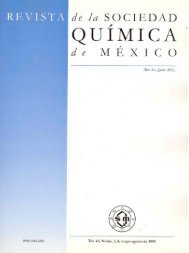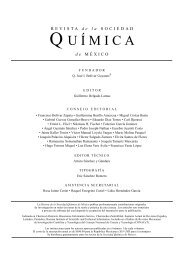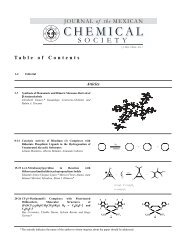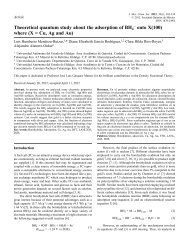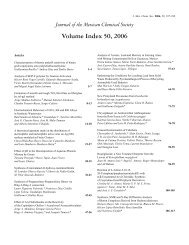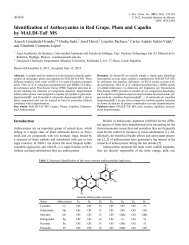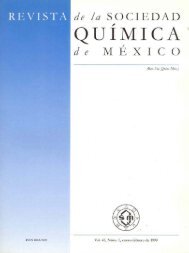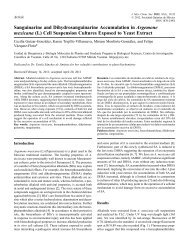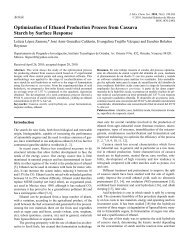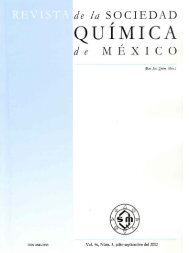SMQ-V047 N-002_ligas_size.pdf - Journal of the Mexican Chemical ...
SMQ-V047 N-002_ligas_size.pdf - Journal of the Mexican Chemical ...
SMQ-V047 N-002_ligas_size.pdf - Journal of the Mexican Chemical ...
Create successful ePaper yourself
Turn your PDF publications into a flip-book with our unique Google optimized e-Paper software.
176 Rev. Soc. Quím. Méx. Vol. 47, Núm. 2 (2003) Laura Alvarez et al.<br />
R 2 O<br />
R 2 O<br />
R 2 O<br />
3 R = H<br />
4 R =<br />
R 2 O<br />
MeOOC<br />
HO<br />
HO<br />
H COOR 1<br />
OR 2<br />
O<br />
O<br />
O<br />
OR<br />
O<br />
O<br />
2<br />
OR 2<br />
O<br />
OR 2<br />
R 1 R 2<br />
1 Glcp H<br />
1a Glcp Ac<br />
2 H H<br />
2a H Ac<br />
2b Me Ac<br />
O<br />
OH<br />
O<br />
RO<br />
Plant Material. The roots <strong>of</strong> V. hypargyrea were collected<br />
near to Durango City, on September 15 th <strong>of</strong> 1997 and identified<br />
by Dr. Robert Bye (Instituto de Biología de la UNAM). A<br />
Botanical sample was prepared and deposited for reference at<br />
<strong>the</strong> National Herbarium <strong>of</strong> Mexico (MEXU) with <strong>the</strong> code<br />
number MEXU961417.<br />
Extraction and Isolation. 200 g <strong>of</strong> <strong>the</strong> methanol extract<br />
obtained previously [4] were fractionated by percolation using<br />
a gradient <strong>of</strong> CH 2 Cl 2 -MeOH yielding six fractions: Fr. I (9:1,<br />
16.0 g); Fr. II (85:15, 2.4 g); Fr. III (4:1, 4.0 g); Fr. IV (7:3,<br />
7.3 g); Fr. V (1:1, 18.2 g) and Fr. VI (3:7, 22.4 g). Fr. I was<br />
purified by column chromatography using mixtures <strong>of</strong> n-hexane-EtOAc;<br />
fractions eluted with 95:5 (n-hexane-EtOAc)<br />
afforded 325 mg <strong>of</strong> friedelin (0.010 %, mp 242-245 °C); from<br />
fractions eluted with n-hexane-EtOAc 9:1 crystallized 83 mg<br />
<strong>of</strong> friedelan-3-β-ol (0.<strong>002</strong>7 %, mp 249-253 °C), fractions eluted<br />
with n-hexane-EtOAc (85:15) yielded 54 mg <strong>of</strong> <strong>the</strong> mixture<br />
<strong>of</strong> β-sitosterol and stigmasterol. Fr. II was applied to a silica<br />
gel column using a gradient system <strong>of</strong> CH 2 Cl 2 -MeOH to yield<br />
1.7 g <strong>of</strong> oleanolic acid (0.056 %, mp 196-198 °C).<br />
Chromatographic analyses <strong>of</strong> Fr. III showed that this was<br />
mainly composed by <strong>the</strong> saponins glucopyranosyl oleanolate<br />
(3), found previously in <strong>the</strong> ethyl acetate extract [4], and 3-O-<br />
(methyl-β-D-glucuronopyranosiduronoate)-28-O-β-D-glucopyranosyl<br />
oleanolate (4, mp 217-218 °C) isolated previously<br />
from V. decurrens [5]. Fr. IV was applied to a silica gel column<br />
using EtOAc-MeOH-AcOH-H 2 O (11:2:2:1) as isocratic<br />
elution mixture. Fractions 8-12 afforded 50 mg <strong>of</strong> 4; fractions<br />
17-26 yielded 12 mg <strong>of</strong> 1 (mp 129-132 °C) and 9 mg <strong>of</strong> 2 (mp<br />
276-278 °C), and fractions 31-43 afforded 820 mg <strong>of</strong> glucose.<br />
18<br />
HO<br />
H<br />
O<br />
O<br />
O<br />
OH<br />
OH<br />
OH<br />
Fr. V was mainly composed by sucrose, identified by direct<br />
comparison with au<strong>the</strong>ntic sample. Fr. VI was ground with<br />
acetone to yield a mixture <strong>of</strong> saponins which was acetylated<br />
with Ac 2 O-Py and <strong>the</strong> residue was chromatographed on silica<br />
gel column using mixtures <strong>of</strong> CH 2 Cl 2 -Acetone: Fractions eluted<br />
with 9: 1 (CH 2 Cl 2 -acetone) yielded 843 mg <strong>of</strong> 1a (0.028 %<br />
<strong>of</strong> dry plant). Fractions eluted with CH 2 Cl 2 -acetone (8:2)<br />
afforded sucrose acetylated and 632 mg <strong>of</strong> 2a (0.021 % <strong>of</strong> dry<br />
plant).<br />
Friedelin, friedelan-3-β-ol and oleanolic acid, were identified<br />
by direct comparison (IR, TLC) with au<strong>the</strong>ntic samples,<br />
while compounds 1a, 2a and 3-4 were characterized by means<br />
<strong>of</strong> physicochemical evidence.<br />
Compound 1a. Oil, [α] D<br />
25 – 4.4° (c 0.05, MeOH); IR<br />
(CHCl 3 ) ν max 2922, 1757, 1452, 1376, 1050 cm –1 ; 1 H NMR<br />
(CDCl 3 , 500 MHz) see Tables 1 and 2; 13 C NMR (CDCl 3 , 125<br />
MHz) see Tables 1 and 2; FABMS m/z 1600 [M + K + H] +<br />
and 1584 [M + Na + H] + , 1254 [M + K – Glc] + , 1068 [M –<br />
rham – xyl] + , 785 [M – glc – rham – xyl] + , 437 [C 30 H 46 O 2 ] + ;<br />
HRFABMS m/z 1561.6983 (calcd for C 77 H 108 O 33 , 1561.<br />
6995).<br />
Compound 2a. Colorless powder, mp 101-102 °C, α D<br />
25 + 6°<br />
(c 0.05, CHCl 3 ); IR (CHCl 3 ) ν max 3500-3400, 2922, 1757,<br />
1452, 1376, 1050 cm –1 ; 1 H NMR (CDCl 3 , 500 MHz) see<br />
Tables 1 and 2 13 C NMR (CDCl 3 , 125 MHz) see Tables 1 and<br />
2; FABMS m/z 1271 [M + K] + , 1255 [M + Na] + , 1233 [M] + ,<br />
958 [M – xyl] + , 954 [M – rham] + , 669 [M – rham – xyl] + , 467<br />
[M – rham – xyl – glc] + ; HRFABMS m/z 1233.4209 (calcd<br />
for C 63 H 92 O 24 , 1233.4212).<br />
Compound 2b. Compound 2a (20 mg) was treated with diazomethane<br />
in diethyl e<strong>the</strong>r to yield 20 mg <strong>of</strong> 2b: Oil, [α] D<br />
25 +<br />
2.5° (c 0.2, CHCl 3 ), IR (CHCl 3 ) ν max 2958, 1728, 1462, 1377,<br />
1072 cm –1 ; 1 H NMR (CDCl 3 , 500 MHz) see Tables 1 and 2;<br />
13C NMR (CDCl 3 , 125 MHz) see Tables 1 and 2.<br />
Acid hydrolysis <strong>of</strong> compounds 1 and 2. Saponins 1 (5 mg),<br />
and 2 (5 mg) in 0.5 M HCl (dioxane-H 2 O, 1:1; 5 ml) were<br />
refluxed on a water bath at 100 °C for 2 h. After cooling, <strong>the</strong><br />
nonpolar reaction product was separated by precipitation with<br />
ice (3 g) and filtration. The aqueous layer was neutralized<br />
with NH 4 OH and reduced to dryness by lyophilization. The<br />
sugars were analyzed by silica gel TLC [EtOAc-MeOH-H 2 O-<br />
AcOH (11:2:2:2)] by comparison with standard sugars.<br />
Alkaline hydrolysis <strong>of</strong> compound 1. The saponin (12 mg) in<br />
KOH 10 % (4 mL) was heated at 100 °C for 75 min. After<br />
acidification with HCl (pH 5), <strong>the</strong> monodesmoside was<br />
extracted with n-BuOH. Comparison with compound 2<br />
demonstrated that both compounds were identical. The aqueous<br />
solution contained glucose was identified by TLC comparison<br />
with an au<strong>the</strong>ntic sample.




